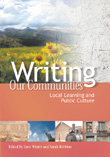 I’m as guilty as any computer-savvy teen of sprinkling my writing with
the abbreviations and shortcuts that are popular in email, online chat, IMs,
and text messages. To be honest, these shortcuts don’t bother me because I like to think that I know enough
about language use to avoid any embarrassing slips into emoticons, acronyms,
and abbreviations in rhetorical situations where they don’t belong.
I’m as guilty as any computer-savvy teen of sprinkling my writing with
the abbreviations and shortcuts that are popular in email, online chat, IMs,
and text messages. To be honest, these shortcuts don’t bother me because I like to think that I know enough
about language use to avoid any embarrassing slips into emoticons, acronyms,
and abbreviations in rhetorical situations where they don’t belong.
The NCTE
Beliefs about the Teaching of Writing explain that “Just as the nature
of and expectation for literacy has changed in the past century and a half, so
has the nature of writing. Much of that change has been due to technological
developments, from pen and paper, to typewriter, to word processor, to networked
computer, to design software capable of composing words, images, and sounds.” Part
of this change has been the development of abbreviations for the words and phrases
used in digital messages. As children and teens learn to use digital tools to communicate with others, they adopt the language of the Internet—its abbreviations, diction, and grammar.
Yes, I said grammar. There is a clear system behind Internet language usage.
Microsoft’s A Parent’s Primer to Computer Slang discusses some of the most basic rules behind the evolving word choice people make online. Describing Leetspeak, the article explains, for instance, how word spelling has evolved:
Numbers and symbols replace the letters that they resemble. You could write the term “leetspeak” as “!337$p34k”. The character “!” replaces the letter L, “3” replaces E, and so on. Other examples of character/letter replacement might include “8” for B, “9” for G, and the number 0 for the letter O.Whatever the Internet language you explore, you will find very specific rules in place that govern diction. Sometimes, as is the case with leetspeak, the rules are playful substitution that creates a special code. Other times, the rules have to do with technological limitations. Many shortened word forms and abbreviations result from the limited length of text messages. If you can use “b4” for the word before, you’ve saved four characters.
Nonstandard capitalization springs from similar roots. Typing a capital letter in a text message requires two keystrokes (one to turn on caps, one for the letter), so writers opt for the faster lowercase version of the words if the meaning will not suffer. Consider the Internet abbreviation “LOL,” which stands for “laugh out loud.” In a cell phone text message, the all caps version could take up to six keystrokes, while the lowercase takes only three. In the frequently high-speed communication of text messages, writers are more likely to opt for the lower number of keystrokes.
Beyond diction and conventions, there are clear grammatical rules at play in the use of Internet slang and communication. A fun example is lolcats, images of cats (like the illustration above) that include playful captions that invoke a grammar all their own. Anil Dash has outlined some of the underlying grammar rules of the lolcats in his blog entry “Cats Can Has Grammar.” The grammar of lolcats includes attention to verb tense, pronoun use, and sentence construction. In fact, lolcats require multimedia literacy skills, as writers combine image with caption and follow conventions for font appearance, caption placement, and overall layout.
The systems that I see Internet writers use don’t indicate laziness or a lack of education. Far from it. They require complex understandings of how language works. When students use Internet language in the wrong place, we shouldn’t mark their work incorrect any more than we would mark students’ use of dialect and home language wrong. What we should do is talk about code-switching and how the uses of Internet language and Standard English contrast. In Code-Switching: Teaching Standard English in Urban Classrooms, authors Rebecca S. Wheeler and Rachel Swords state:
When we talk about “proper grammar”; and “good English,” we make a lot of assumptions about the nature of language. We assume that English is Standard English. We assume that Standard English is Right with a capital R, and that anything else is improper, bad, incorrect, and fractured. Indeed, we seem to believe that anything other than Standard English is pretty much not English. (5)Their observation fits Internet language well. Articles like the Hartford Courant’s “R T33ns KO'ing Eng?” begin with the notion that there is or may be something wrong with writers’ use of emoticons, acronyms, and abbreviations in digital messages and texts. In truth, it’s not error. It's just language in use in new and creative ways. The best thing teachers can do is take advantage of this language play and explore the ways that words and phrases and clauses work in the different kinds of language that we all use.
READERS: Please take a second after reading to share some immediate feedback by clicking the comment buttons below that reflect your reaction to this entry! I’m always trying to improve the blog, and your feedback will help me make sure I’m meeting your needs.















